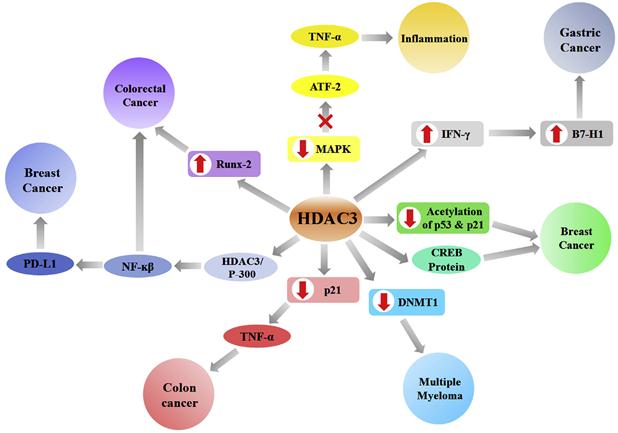
Our promise to you:
Guaranteed product quality, expert customer support.
 24x7 CUSTOMER SERVICE
24x7 CUSTOMER SERVICE
 CONTACT US TO ORDER
CONTACT US TO ORDER
HDAC3 Gene Editing 
Histone deacetylases (HDACs) have attracted the attention of researchers not only for their ability to deacetylate histones but also for deacetylate other non-histone proteins resided in the nucleus, cytoplasm, as well as mitochondria. HDACs regulate diverse cellular events such as compacting of chromatin into a repressed state. HDACs are important regulators of gene expression, and their inhibition has been implicated as a potential therapeutic strategy in multiple cancer types. HDAC3, a class I HDAC, generates a stable complex with the nuclear receptor corepressor (N-CoR) or silencing mediator of retinoic and thyroid receptors (SMRT) to display its maximal enzymatic activity. HDAC3 is an important zinc-dependent metalloenzyme that can implicate various human diseases through epigenetic modulations. The role of HDAC3 is correlated in several life-threatening diseases like cancers, diabetes, inflammatory diseases, neurodegenerative disorders, cardiovascular diseases, learning and memory dysfunctions, Huntington's disease (HD), etc.
Hdac3 was originally found in homology searches using the other class 1 HDACs and has been largely studied as a component of the NCOR/SMRT repression complex, which is recruited by nuclear hormone receptors and other site-specific DNA binding factors to repress the expression of individual genes. Due to the role of nuclear hormone receptors (such as the retinoic acid receptor) in hematopoiesis, Hdac3 may be a target for the effects of HDAC inhibitors on differentiation. Interestingly, gene deletion in mice has suggested that Hdac3 also contributes to the control of global levels of histone acetylation that regulate chromatin structure. Cells lacking Hdac3 showed increases in H4K5ac, H4K12ac, and in some cases H3K9/K14ac, leading to a loss of heterochromatin, an increase in DNA double-strand breaks, and affected proliferation. This resulted in embryonic lethality, but deletion in adult tissues was surprisingly tolerated. However, deletion of Hdac3 in the heart or the liver caused hypertrophy, which was accompanied by altered metabolism. When deleted in the liver, Hdac3 inactivation results in a fatty liver phenotype, as well as disruptions in circadian rhythms.
Role of HDAC3 in cancer
In many cases, overexpression of HDAC3 is directly correlated with the expression of different cancer regulatory genes. In colorectal cancer, overexpression of HDAC3 leads to a decrease in the expression of p21. Inhibition of HDAC3 induces the acetylation process of p53 and p21 expression, leading to G1 phase arrest in triple-negative breast cancer. HDAC3 inhibits mitogen-activated protein kinase (MAPK)-dependent activation of transcription factor-2 (ATF-2) to suppress the expression of TNF-a. HDAC3 can inhibit the metastatic potential of colorectal cancers by binding to the promoter sequences of Runt-related transcription factor 2 (Runx 2). It can reduce the proliferative potential of metastatic breast cancer cells by binding to the CREB protein. Downregulation of HDAC3 increases the chances of tumor formation of lung cancer cells and also inhibits the growth of cholangiocarcinoma by increasing apoptosis. HDAC3 may also minimize the potential of angiogenic growth in melanoma cells.
 Figure 1. Relation between HDAC3 and various cancer. (Sarkar R, et al. 2020)
Figure 1. Relation between HDAC3 and various cancer. (Sarkar R, et al. 2020)
According to Jiang et al., HDAC3 is required to proliferate adult neural stem/progenitor cells (NSPCs). It controls the progression of G2/M phase through posttransitional stabilization of cyclin-dependent kinase 1 (CDK1). Thus, HDAC3 plays a key role in NSPC proliferation, indicating that using HDAC3 inhibitors is a good strategy for controlling cancer growth. Edderkaoui and co-workers revealed that HDAC3 has a specified role in smoking-induced pancreatic adenocarcinoma. It has been found that due to smoking there was a significant increase in the phosphorylation level of HDAC3. Therefore, it causes translocation of phosphorylated HDAC3 in the nucleus. Inhibition of HDAC3 reduces the level of IL-6 produced by the cancer cells and plays an important role as a stimulator in the interaction between tumor-promoting macrophages and cancer cells. Thus, targeting HDAC3 by a novel mechanism may be useful for cancer therapy.
HDAC3 Gene Editing Services
CRISPR/Cas9 PlatformCB at Creative Biogene is dedicated to offering comprehensive CRISPR/Cas9 gene editing services and products for academic research, biotech research and pharmaceutical drug discovery. With deep gene editing knowledge and extensive experience in experimental operation and data processing, we help you effectively control HDAC3 genes knockout/knockin/point mutation in cells or animals via CRISPR/Cas9 technology.
| Service | Details | Alternative cell lines or animal species |
| HDAC3 Gene Editing Cell Line Generation | gRNA design and synthesis Transfect the cell lines you're interested Select the high expression cells and sort monoclonal cell Validate the knockout/knockin/point mutation of HDAC3 by PCR and sequencing Provide cryogenically preserved vials of stable cells and final reports | HEK239T, Hela, HepG2, U87, Ba/F3, CHO, MDA-MB-453, MDA-MB-231NIH3T3, T47D, Neuro2a, MCF7, RKO, K562, RAW264.7, etc. |
| HDAC3 Gene Editing Animal Model Generation | HDAC3 gene conventional knockout animals HDAC3 gene conditional knockout animals HDAC3 point mutation animals HDAC3 knockin animals | Mouse, rat, rabbit, zebrafish, C. elegans, etc. |
Related Products at CRISPR/Cas9 PlatformCB
References
- Amin S A, et al. Designing potential HDAC3 inhibitors to improve memory and learning. Journal of Biomolecular Structure and Dynamics, 2019, 37(8): 2133-2142.
- Sarkar R, et al. Histone deacetylase 3 (HDAC3) inhibitors as anticancer agents: A review. European Journal of Medicinal Chemistry, 2020, 192: 112171.
- Meier B C, Wagner B K. Inhibition of HDAC3 as a strategy for developing novel diabetes therapeutics. Epigenomics, 2014, 6(2): 209-214.
- Summers A R, et al. HDAC3 is essential for DNA replication in hematopoietic progenitor cells. The Journal of clinical investigation, 2013, 123(7): 3112-3123.